http://www.chemistrymag.org/cji/2007/0930012pe.htm |
Mar. 2,
2007 Vol.9 No.3 P.12 Copyright |
Huo
Guoyan,Yang Qing, Dong Fuying, Song Dayong
(School of Chemistry and Environmental Science, Hebei University, Baoding 071002, China)
Received Dec. 24, 2006; Supported by Foundation for Doctorate, Education Department of Hebei Province (B2002102), China.
ABSTRACT The structure, electrical
transport and magnetic properties of the series of La1-xSrxFe1-xMnxO3
(0.3≤x≤0.7)
compounds have been studied. The lattice parameter, a, decreases firstly and
following increase with Sr2+ and Mn4+ doped. The cell parameters, b
and c, decrease slightly with coupled substitution of Sr2+ for La3+
and Mn4+ for Fe3+. All the magnetic transition temperatures of the
samples are below 80.0 K. The electrical behaviors of all specimens demonstrate insulator
and the electrical resistivity increases with Mn4+ and Sr2+ ions
doped. The detailed analysis of electrical transport shows that the electrical process of
some samples are controlled by variable range hopping model at low temperature and that
the electrical transport of the others are described by two steps transport of small
polaron model at low temperature and that electrical transport of all specimens is
described by bipolaron model at high temperature.
Keywords Structure, Magnetic
properties, Electrical transport, Coupled substitution
1. INTRODUCTION
With the discovery of colossal magnetoresistance (CMR) effect in manganites,
hole-doping perovskite manganites with unusual electronic transport and magnetic
properties have attracted considerable attention. These properties result from an
intrinsic interaction among charge, spin, orbit and lattice degrees of freedom that are
strongly coupled to each other[1-2]. Double exchange model combined with
John-Teller effect was used to explain these properties partly[3].
A great deal of work has
been carried out on the manganites Ln1-xAxMnO3 since the
discovery of colossal magnetoresistance properties in these compounds[4]. Also,
many studies have been carried out on the Mn site doping effect (formula A'1-xA''xB'1-yB''yO3)[5-6].
The research work reported by Takeuchi et al.[7] suggests that Fe substitution
for Mn dilutes the DE mechanism and shows typical spin glass and insulating behaviors. The results for several authors to study the Ln1-xAxMn1-yFeyO3
Fe-doped manganites with y≤ x indicate that
Fe and Mn host lattice is antiferromagnetic interaction[8-10].
To our knowledge,
there is little data which are available on coupled A-B-site substitutions in ABO3[11-12].
On the basis of previously published experimental data[11-12], we may expect
that a coupled substitution involving Sr and Mn would improve the properties of LaFeO3.
So if Sr is doped at La-site and Mn doped at Fe-site, useful information for understanding
could be obtained.
The purpose of the present study is to clarify the transport mechanism
in the mixture of manganites La1-xSrxFe1-xMnxO3
(0.3≤x≤0.7)
and to show how the properties change with the replacement of La by Sr and Fe by Mn.
2. EXPERIMENTAL
Polycrystalline
samples of La1-xSrxFe1-xMnxO3 (0.3≤x≤0.7) were
prepared by standard solid-state reaction from stoichiometric amounts of La2O3,
SrCO3, Fe2O3 and MnO2 , the purities of which are, at least, 99.9%.
A purity of 99.99% La2O3 powders was dried for
5 hours at 8000C before used. The mixtures were ground by hand in an agate
mortar for at least 40 min and pressed into pellets, then preheating the pellets for 8 hours at 8000C. Following then the mixtures was ground
extensively once again. Then the powders were pressed into pellets and annealed at 11000C
in air for 24 h with intermittent grindings and finally cooled the samples down to 5000C at 20C/min,
then cooled to room temperature in furnace.
Temperature dependence of magnetization curve was measured by a vibrating sample magnetometer (VSM) in a field of 0.5 T over the temperature range 80-300 K. Electrical resistances were determined by the standard four-probe DC method in the range 80-300 K.
3. RESULTS AND
DISCUSSION
3.1 Crystal structure
The products of synthesis by standard solid state technique yielded
single-phase materials, which were confirmed by powder XRD (see Fig.1). The XRD patterns
of all samples can be indexed in the orthorhombic system with space group Pnma.
The lattice parameters of La1-xSrxFe1-xMnxO3
compounds were determined by XRD. This type of structure is common for rare earth
perovskite-type oxides. Each unit cell consists of four ABO3 units, and has the
approximate dimensions![]() , where ap
is the lattice parameter of the ideal cubic unit cell. The determined lattice parameters
of the orthorhombic cell are shown in Table 1.
, where ap
is the lattice parameter of the ideal cubic unit cell. The determined lattice parameters
of the orthorhombic cell are shown in Table 1.
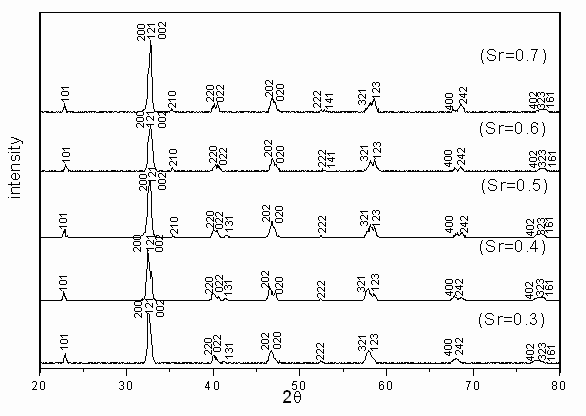
Fig. 1 X-ray patterns of the series La1-xSrxFe1-xMnxO3
(0.3≤x≤0.7)
Table 1. Lattice parameters, unit cell volume, and
qCW (K) of the system La1-xSrxFe1-xMnxO3 (0.3≤x≤0.7)x |
a(nm) |
b(nm) |
c(nm) |
v(nm3) |
a, b, c/ |
θCW (K) |
0.3 0.4 0.5 0.6 0.7 |
0.55578 0.55231 0.55075 0.55201 0.55308 |
0.77824 0.77736 0.77728 0.7764 0.77544 |
0.55006 0.54903 0.54817 0.54826 0.54791 |
0.23792 0.23572 0.23466 0.23497 0.23499 |
c<b/ c<b/ c<b/ c<b/ c<b/ |
-263K -175K -56K -183K -263K |
It can be seen from Table 1 that the variations of the
orthorhombic lattice parameter, a, decreases with Sr content from Sr = 0.3 to 0.5,
following then increases with coupled substitution of La3+ by Sr2+
and Fe3+ by Mn4+ and that the change of lattice parameters, b
and c, reduce slightly with the replacement of La3+ by Sr2+
and Fe3+ by Mn4+. This is due to the tilting scheme of BO6
octahedral in Pnma perovskite, of the type a+ b- b-
in Glazer's nomenclature[13], in which the distortion driven by the
increase of average A size and by the reduction of average B size leaves b and c
to decrease slightly. Whilst, the variance of lattice parameters confirm that the
compounds form solid solutions but not two compounds simply mixed. The observed size in
unit cell volume decreases with the coupled substitution of the La3+ by Sr2+
with that of the
Fe by Mn from Sr = 0.3 to 0.5, following then increases slightly with the coupled
substitution from Sr = 0.5 to 0.7 (see Table 1). The reason for decrease of this parameter
from Sr = 0.30 to 0.50 is that on A site substitution of small radius La3+ by
big radius Sr2+ and on B site replacement of big radius Fe3+ by
small radius Mn4+, the reduction out of phase tilting caused by distortions of the O-B-O angles of the
octahedral for fitting the size of A average size plays an important role[14-15].
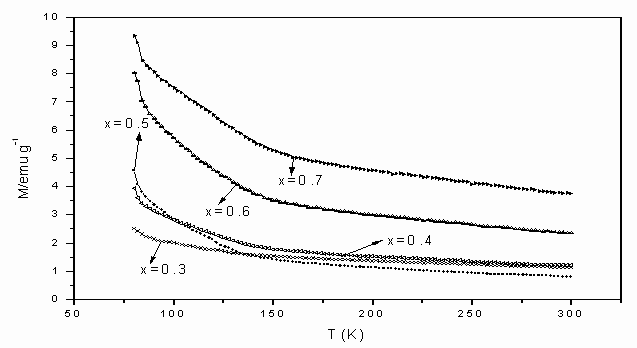
Fig. 2 The temperature
dependence of magnetization (M) of La1-xSrxFe1-xMnxO3
samples measured under H = 0.5T
3.2 Magnetic properties
Fig. 2 presents the temperature-dependent
magnetization (M-T) of the La1-xSrxFe1-xMnxO3
system under a magnetic field of 0.5T. It can be seen from Fig. 2 that the magnetic
transition temperatures of the samples are below 80.0 K. The susceptibility presents the
Curie-Weiss-type behavior [c = C/(T-q)] for the temperatures above 80.0 K. Here, C and q are Curie
constant and Curie-Weiss temperature, respectively. The values of q of all samples
are negative (see Fig. 3 and Table 1), indicating that the local magnetization below
magnetic transition temperatures are associated with the antiferromagnetic coupling.
Curie-Weiss temperature is related to the strength of antiferromagnetic interaction. With
the increase Sr and Mn contents from 0.30 to 0.50 the Curie-Weiss temperatures increase to
high temperatures. This indicates that antiferromagnetic interactions become weak. With
increasing Sr and Mn content from 0.50 to 0.70 the Curie-Weiss temperatures decrease to
low temperatures again. This suggests that antiferromagnetic interaction is strengthened. From the variation of Curie-Weiss
temperature with Sr content (x) (see Table 1) it can be inferred that the double exchange
interactions between neighboring Fe3+ and Mn4+ ions is relatively
strong but short range interactions which are responsible for the formation of the
ferromagnetic correlation as overlapping of eg for Fe3+
and eg for Mn4+[16] and that the exchange interactions
between Fe3+/Mn4+ and Fe3+/Mn4+ are strong and
long range antiferromagnetic.
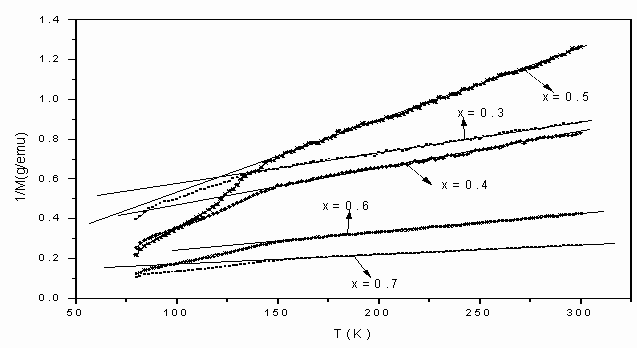
Fig. 3 The reciprocal magnetization (1/M) for La1-xSrxFe1-xMnxO3
samples, the solid lines are fitted to the Curie-Weiss law
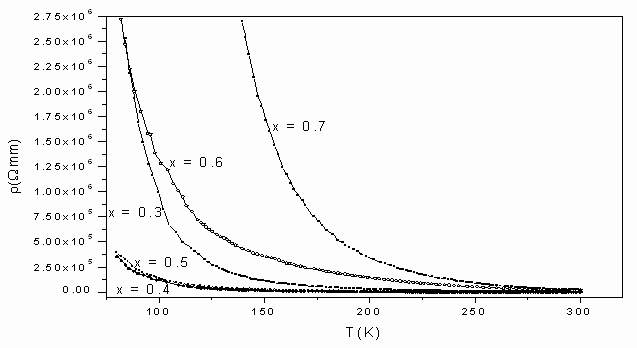
Fig. 4 The temperature dependence of electrical resistivity for
polycrystalline samples of the solid solution La1-xSr xFe1-x MnxO3
(0.3≤x≤0.7) as
a function of temperature
3.3 Electrical
resistivity
The temperature dependence of the electrical
resistivity of all samples is shown in Fig. 4. Insulating behaviors are observed for all
samples in the studied temperature range. As some samples resistances are too high to be
measured on our apparatus at low temperatures we can not obtain the values of resistances
below certain temperature. It can be seen from Fig. 4 that the resistivity of La0.6Sr0.4Fe0.6Mn0.4O3
compound is the lowest among them and of all other samples increase with Sr2+
and Mn4+ doping from x = 0.3 to 0.7 (except x = 0.4). One hand, as well known,
the amount of Mn3+/Mn4+ = 7/3 ~ 6/4 the double exchange effect is
the strongest in La1-yCayMnO3 compounds and La1-xSrxFe1-xMnxO3
compounds are similar to La1-yCayMnO3 compounds,
therefore, the resistivity of La0.7Sr0.3Fe0.7Mn0.3O3
and La0.6Sr0.4Fe0.6Mn0.4O3
compounds is low, and the resistivity of the others obviously increases with deviation
from 7/3 ~ 6/4 due to double exchange weakening and to Fe3+-O-Mn4+
angle decreased as lattice deformation increasing. On the other hand, with Sr2+
and Mn4+ further substitution for La3+ and Fe3+
antiferromagnetic interaction is promoted by increasing the proportion of Mn4+-O-Mn4+.
Therefore, the resistivity evidently is enhanced.
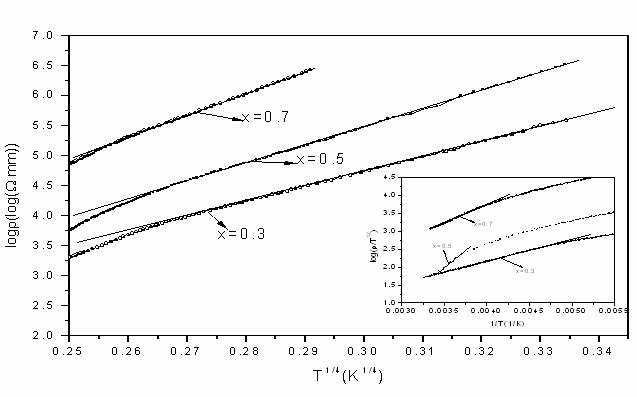
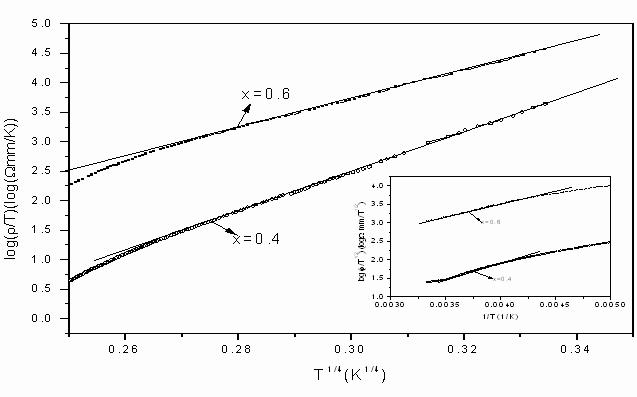
Fig. 5 (a) log r vs. T-1/4, inset log(r /T1/2 ) vs.
1/T; (b) log r / T vs. T-1/4, inset log(r /T1/2 ) vs. 1/T plots for
La1-xSr xFe1-x MnxO3 (0.3≤x≤0.7) samples
In order to get more insight into the transport processes, the electrical resistivity data were fitted to various model applied for materials. Fig. 5 shows the electrical transport behaviors for x = 0.3, 0.4, 0.5, 0.6 and 0.7 samples. It can be seen from Fig. 5 that variable range hopping between localized states is demonstrated for x = 0.3, 0.5 and 0.7 at low temperature (see Fig. 5a) and that two steps transport of small polarons model is confirmed for x = 0.4, 0.6 at low temperature (see Fig. 5b). At high temperature the electrical transport behaviors of all specimens show bipolaron model (see inset of Fig. 5).
4. CONCLUSIONS
We have investigated the structure,
electrical transport and magnetic properties of the series La1-xSrxFe1-xMnxO3
(0.3≤x≤0.7) compounds. The lattice parameter, a, decreases firstly
with 0.3≤x≤0.5
and following then increases with 0.5≤x≤0.7. The lattice parameters b and c reduce slightly
with coupled substitution of Sr2+ and Mn4+ for La3+ and
Fe3+. The detailed analysis of magnetic properties demonstrates that local
magnetic interaction between Fe3+/Mn4+ and Fe3+/Mn4+
at below magnetic transition temperature is antiferromagnetic. The electrical behaviors of
all specimens demonstrate insulator and the electrical resistivity increases with Mn4+
and Sr2+ ions doped. The detailed analysis of electrical transport shows that
the electrical process of all samples are controlled by variable range hopping between
localized states or two steps transport of small polaron model at low temperature and that
the electrical transport are described by bipolaron model at high temperature.
REFERENCES
[1] Helmolt R V, Wecker J, Holzapfel B, et al., Phys. Rev. Lett., 1993, 71: 2331-2333.
[2] Jin S, Tiefel T H, McCormack M, et al., Science, 1994, 264: 413-415.
[3] Millis A J, Littlewood P B, Shraiman B I,
Phys. Rev. Lett., 1995, 74: 5144-5147.
[4] Kusters R M, Singleton J, Keon D A, et al., Physica B, 1989, 155: 362.
[5] Schuddinck W, Tendeloo G V, Barnabe A, et al., J. Magn. Magn. Mater., 2000, 211:
105-110.
[6] Kostogloudis G Ch, Fertis P and Ftikos Ch, Solid State Ionics,
1999, 118: 241-249.
[7] Takeuchi J, Uemura A, Miyoshi K, et al., Physica
B, 2000, 281-282: 489-490.
[8] Simopoulos A, Pissas M, Kallias G, et al, Phys. Rev. B, 1999, 59: 1263-1271.
[9] Leung L K, Morrish A H, Evans B J, Phys. Rev. B, 1976, 13: 4069-4078.
[10] Blanco J J, Insausti M, Muro I G, et al., Solid State Chem., 2006, 179: 623-631.
[11] Asthana S, Nigam A K, Bahadur D, Appl. Phys., 2005, 97: 10C101-3.
[12] Mitchill R H, Chakhmouradian A R, Solid State Chem, 1999, 144: 81-85.
[13] Howard C J, Stokes H T, Acta Cryst, 2005, A61: 93-111.
[14] Woodward P M, Vogt T, Cox D E, et al, Chem. Mater, 1998, 10: 3652-3665.
[15] Hanna F F, Egypt J. Sol, 2001, 24: 33-40.
[16] Ahn K H, Wu X W, Liu K, et al., Phys. Rev. B, 1996, 54: 15299-15302.
霍国燕 杨青 董福营 宋大勇
(河北大学化学与环境科学学院 河北 保定 071002)
摘要 对系列复合化合物La1-xSrxFe1-xMnxO3 (0.3≤x≤0.7)的结构、电学性质和磁学性质进行了研究。晶胞参数a随着Sr2+ 和Mn4+ 分别对La3+和Fe3+的替代量的增加先减小后增大,而晶胞参数b、c则逐渐减小。所有样品的磁转变温度都低于80K。在所测的温度范围内所有样品都呈现绝缘体性,而且样品的电阻率随着Sr和Mn的掺入量的增多而相应地增加。另外还对样品的导电机制进行了研究,分别对样品进行了各种电输运模型的拟合,发现在低温时,有的样品的导电机制符合变程跃迁模型,有的则符合小极化子两步运输模型;而在高温时,所有的样品都符合双极化子模型。
关键词 结构,磁性质,电运输,双掺杂